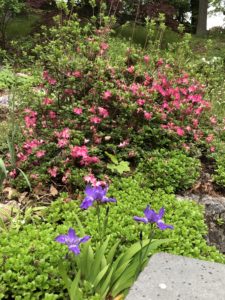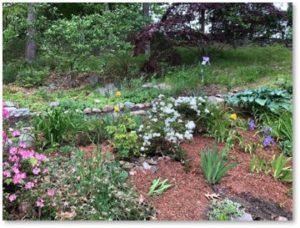 The season for plant sales has ended but now the work begins. I like to work in the garden and there are many benefits to gardening. Just to name a few, gardening:
The season for plant sales has ended but now the work begins. I like to work in the garden and there are many benefits to gardening. Just to name a few, gardening:
- Connects you to nature
- Supports mental health and wellbeing
- Creates communities and friendships
- Improves your sensory awareness
- Helps you sleep better
- Burns calories, builds strength and decreases osteoporosis
- Lowers stress and blood pressure
- Helps reduce the risk of stroke
- Can help you eat more healthily
- Teaches you information and skills
- Exposes you to beneficial bacteria
- Is good for air quality
- Provides ecosystems for animals and the bees
The downside of gardening, if one can call it that, is the expense. The tools cost money, of course, and one always “needs” nice new tools. But once you have a good set, really, one can ignore that urge.
The Three Types of Gardening
The second expense comes with buying plants and plant lust is strong. Vegetable gardeners scrutinize catalogs while snow piles up outside, planning what they will grow come spring and what they will do with their bountiful harvest. Annual gardeners think of hanging pots and displays, groups of flowers, colors and shapes to decorate the property this year.
But perennial gardeners—and I am one—plan for the long haul. What we put down this year will come back in subsequent seasons. Sometimes the plants return and grown bigger every year while others take a year off and surprise you in the second season.
Conversely, a flower that was flourishing can, mysteriously, grow sparse. The beebalm in this photo, for example, has dwindled to a shadow of its former self. And the stachys, or Lamb’s Ears, in the lower right corner died out altogether.
Now, all three types of gardens require plants. Some folks grow them from seed with elaborate set-ups for nurturing the seedlings to a size where they can go into the ground. Others visit nurseries to buy flats and six-packs of greenhouse-grown flowers from begonias to zinnias.
Plant Sales Are Flourishing
Perennial gardeners, however, love plant sales. These events, typically fund-raisers for garden clubs, churches, and charities, take place in the spring. We search for their dates and put these sales on our calendars. Then we organize our Saturdays to make sure we get to the sale early.
The pandemic put a crimp in the annual plant sales for a few years. Some returned last year while others went online instead of in-person. But shopping online simply can’t match the pleasure of browsing among the pots and selecting exactly the flowers you want.
 These plants, you see, come from personal gardens. They are out-takes from plants that have grown bushy or spread too widely. Perhaps the gardener wants to try something new and needs place to put it. Or that big tree has grown so big it now shades what was once a sunny garden. The solution is to take something out, pot it, and contribute it to the plant sale.
These plants, you see, come from personal gardens. They are out-takes from plants that have grown bushy or spread too widely. Perhaps the gardener wants to try something new and needs place to put it. Or that big tree has grown so big it now shades what was once a sunny garden. The solution is to take something out, pot it, and contribute it to the plant sale.
NOTE: These days the donors remove the soil, wash the roots, and re-pot the plants in potting soil. This extra work and expense is designed to foil the spread of Asian Jumping Worms, which are destructive to both plants and soil.
So Many Plant Sales, So Little Time
Experience tells you which plant sales are the best, thus where to focus your time and money. This Saturday, I chose among the four plant sales in the area and got there 10 minutes before it opened. The line already stretched from the entrance to the corner and around the other side of the block. When the clock on the town hall across the street struck nine, they opened the gates and we streamed in.
Many people pulled wagons to haul their pots but I just carried a box. The size and weight limited me so I had to be selective and couldn’t go hog wild. First, I decided between sun and shade. My perennial border has both, so I had to pick which area to focus on. I chose sun. After sun came shade and then native plants. I left with a boxful of beautiful perennials that didn’t leave too much of a dent in the budget.
Sun or Shade at the Plant Sale
 Then I drove to the second of the two sales I had prioritized only to find that this one had already been picked over by another long line of patient perennial gardeners. Nothing of interest to me was left.
Then I drove to the second of the two sales I had prioritized only to find that this one had already been picked over by another long line of patient perennial gardeners. Nothing of interest to me was left.
My third stop was my church, where I work on the Memorial Garden in my (insufficient) spare time. It was going to rain and I wanted to plant a couple of my shade selections there before the drops started falling. After that I headed home, damp and dirty but happy.
Perennial Patience
I wish that the plant sales were more spread out so I could go to more. That would, of course, only mean more time and money, so I guess it’s a good thing that they cluster on the same Saturdays.
Gardeners are generous people. We love to share information and ideas, plants and pots. One can talk to perfect strangers while waiting in line or shopping the tables and have a good time.
During the pandemic, this work sustained me. The garden gave me a place to go where I could be outside, mostly alone, and maskless. Sometimes several of us show up at the church’s Memorial Garden to work comfortably and quietly together.
The plant sales appear to be over for this year but now the work begins as we dig, water, and fertilize. Always we work with an eye to how it will look next year and the year after. Perennial gardening is not for those who want immediate gratification. But the end results are worth it.


